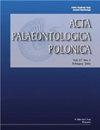Why tyrannosaur forelimbs were so short: an integrative hypothesis
IF 1.9
3区 地球科学
Q2 PALEONTOLOGY
引用次数: 0
Abstract
The unusually shortened limbs of giant theropods, including abelisaurids, carcharodontosaurids, and derived tyrannosauroids such as Tyrannosaurus rex have long been an object of wonder, speculation, and even derision on the part of both paleontologists and the public. Two questions commonly asked are “Why did the forelimbs become so short?” and “What did the animals use such short forelimbs for, if for anything?” Because basal tyrannosauroids and their outgroups, as well as the outgroups of other giant theropods, had longer forelimbs, the foreshortening of these elements in derived taxa was secondary, and it ostensibly involved a shift in developmental timing of the forelimb elements. Factors proposed to have influenced the evolutionary foreshortening include natural selection, sexual selection, energetic compensation, ontogenetic vagaries, and rudimentation due to disuse. Hypotheses of use have varied from a supporting anchor that allows the hindlimbs a purchase to stand from a reclining position to a pectoral version of pelvic claspers during inter-course to a sort of waving display during sexual or social selection. None of these hypotheses explain selective regimes for reduction; at best, they might argue for maintenance of the limb, but in all cases a larger limb would have suited the function better. It is likely that we have been looking the wrong way through the telescope, and that no specific function of the forelimbs was being selected; instead, another crucial adaptation of the animal profited from forelimb reduction. Here I propose, in the context of phylogenetic, ontogenetic, taphonomic, and social lines of evidence, that the forelimbs became shorter in the context of behavioral ecology: the great skull and jaws provided all the necessary predatory mech-anisms, and during group-feeding on carcasses, limb reduction was selected to keep the forelimbs out of the way of the jaws of large conspecific predators, avoiding injury, loss of blood, amputation, infection, and death. A variety of lines of evidence can test this hypothesis.为什么暴龙的前肢如此短:一个综合假说
巨大的兽脚亚目恐龙,包括阿贝利龙、齿龙,以及雷克斯暴龙等暴龙的衍生类恐龙的异常缩短的四肢,长期以来一直是古生物学家和公众好奇、猜测甚至嘲笑的对象。两个常被问到的问题是:“为什么前肢变得这么短?”以及“这些动物用这么短的前肢做什么,如果有什么用的话?”由于基生暴龙及其外群,以及其他大型兽脚亚目的外群,前肢较长,因此衍生类群中这些元素的提前缩短是次要的,表面上看,这与前肢元素发育时间的改变有关。影响进化缩短的因素包括自然选择、性选择、能量补偿、个体发生变异和因废弃而产生的初始化。关于这种用法的假设多种多样,从使动物的后肢从倾斜的位置站立的支撑锚,到性交时骨盆扣的胸端,再到性选择或社会选择时的一种挥舞展示。这些假设都不能解释选择性还原机制;在最好的情况下,他们可能会争论维持肢体,但在所有情况下,更大的肢体更适合功能。很可能是我们通过望远镜看错了方向,没有选择前肢的特定功能;相反,动物的另一个关键适应得益于前肢的减少。在这里,我提出,在系统发育、个体发育、分类学和社会证据的背景下,前肢在行为生态学的背景下变得更短:巨大的头骨和颌骨提供了所有必要的捕食机制,在集体进食尸体时,肢体减少被选择,以使前肢远离大型同种捕食者的颌骨,避免受伤、失血、截肢、感染和死亡。各种各样的证据可以检验这一假设。
本文章由计算机程序翻译,如有差异,请以英文原文为准。
求助全文
约1分钟内获得全文
求助全文
来源期刊

Acta Palaeontologica Polonica
地学-古生物学
CiteScore
2.80
自引率
5.60%
发文量
36
审稿时长
12.5 months
期刊介绍:
Acta Palaeontologica Polonica is an international quarterly journal publishing papers of general interest from all areas of paleontology. Since its founding by Roman Kozłowski in 1956, various currents of modern paleontology have been represented in the contents of the journal, especially those rooted in biologically oriented paleontology, an area he helped establish.
In-depth studies of all kinds of fossils, of the mode of life of ancient organisms and structure of their skeletons are welcome, as those offering stratigraphically ordered evidence of evolution. Work on vertebrates and applications of fossil evidence to developmental studies, both ontogeny and astogeny of clonal organisms, have a long tradition in our journal. Evolution of the biosphere and its ecosystems, as inferred from geochemical evidence, has also been the focus of studies published in the journal.
 求助内容:
求助内容: 应助结果提醒方式:
应助结果提醒方式:


